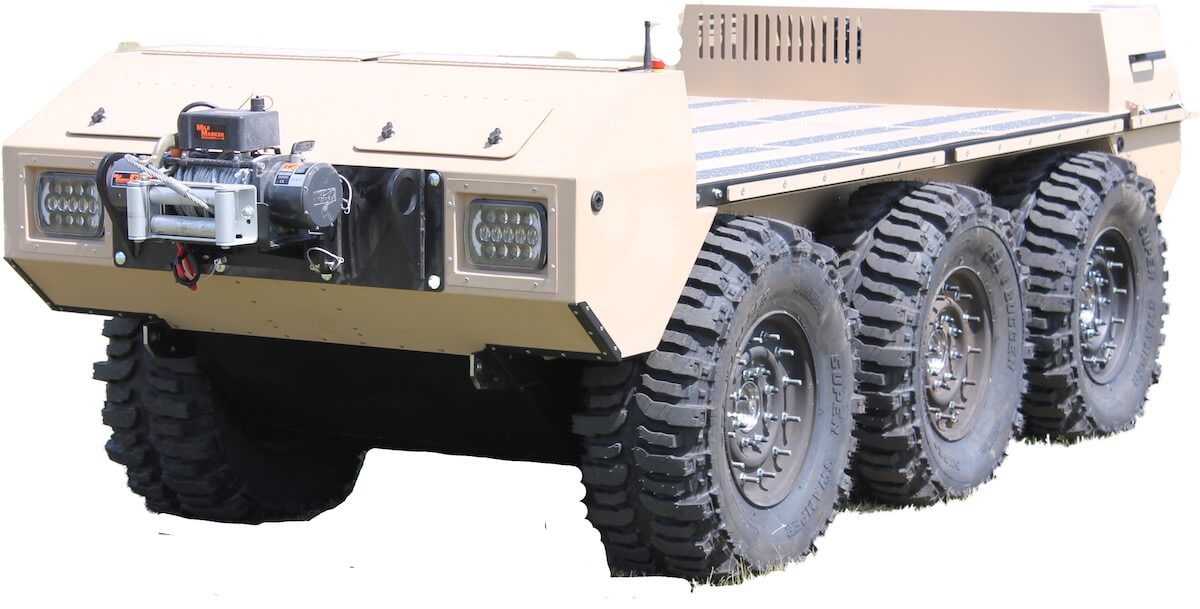Case Study
Hippo Multipower
Find out more about the development of Hippo’s range of Hybrid Diesel Electric Vehicles; the optionally (un)crewed HAWC and the fully uncrewed RAPTOR
Background Situation
Light Forces
Light forces have a high degree of strategic and operational mobility as they are capable of being deployed rapidly into and within theatres by air and aviation assets. This provides not only a rapid theatre intervention capability to deal with emerging threats, but also the ability to achieve operational and tactical surprise.
Light forces are optimised for complex terrain such as jungles, mountains and the dense urban environment where the terrain prevents the deployment of armoured and mechanised platforms or speed necessitates the rapid deployment of forces by air.

Contains public sector information licensed under the Open Government Licence v3.0
However, light forces are limited in their tactical agility and operational endurance by the quantity of equipment and combat supplies that they can physically carry.

Contains public sector information licensed under the Open Government Licence v3.0
Distributing a typical combat load across a 29-strong platoon sees an additional 27 kg of load on top of the 33 kg of assault load – a staggering 60 kg. No wonder that musculoskeletal injuries are so prevalent among infantry soldiers.
DEFINING THE PROBLEM
The Burden on the Soldier
In 1950 SLA Marshal published “The Soldier’s Load and the Mobility of a Nation.” He concluded that a soldier should carry no more that 1/3 of their body weight. Further UK research in the early 2000s in support of the Future Integrated Soldier Technology (FIST) project and the Platoon Combat Experiment 2013-15 supported this conclusion. For the average infantry soldier that is a load of no more than 24 kg.
The British Army has a policy of “Fight Light” to minimise the amount of equipment carried. However, even under “Fight Light” the current assault load is more than 33 kgs.
Furthermore, in order to get into an assault position, soldiers are required to carry other equipment such as rations and water, spare ammunition, entrenching tools, anti-armour weapons, radios, electronic counter measures, mortar ammunition, 40mm grenades, machine gun ammunition etc.
THE SOLUTION
The Hippo Hybrid All Terrain Wheeled Carrier (HAWC)
The HIPPO HAWC addresses the challenges for light forces in four ways:
- Load carriage
- Mobility
- Power generation
- Optional robotics

The Hippo Hybrid All Terrain Wheeled Carrier (HAWC)
Payload

HAWC and RAPTOR have a payload of 1000 kg. They can be rapidly reconfigured with different payloads including
Mobility

The HIPPO HAWC and RAPTOR can be rapidly deployed by air and aviation assets. They are air droppable by parachute and can be internally transported by support helicopter such as CH-47 or underslung by utility helicopters eg UH-60.
The electric drive motors give the HAWC and RAPTOR massive amounts of torque and rapid acceleration. The all wheel drive and skid steer provide the HAWC and RAPTOR with excellent terrain accessibility in the most demanding conditions including sand, snow, swamp, jungle, forest and mountain terrain.
When operating on battery power, the HAWC and RAPTOR have extremely low thermal and acoustic signature. An integrated diesel generator provides the vehicles with range and endurance.
Exportable Power

Robotics & Autonomous Applications

HIPPO has a proven track record in supplying autonomous vehicles. The previous “ATSV” platform was supplied to the British Army as part of the Robotic Platoon Vehicle (RPV) Spiral 1 as well as the Autonomous Last Mile Resupply (ALMR) project.
All HIPPO HAWC platforms are “drive by wire” allowing a robotic applique kit to be fitted. The level of autonomy can be defined by the customer; ranging from line of sight remote control to “follow me,” waypoint navigation, route selection, GNSS denied navigation and obstacle detect obstacle avoid (ODOA).
The HAWC retains the ability for a human operator to get into the vehicle and drive providing redundancy in the system and allowing operations in heavily contested electromagnetic environments or under strict EMCON measures.
The RAPTOR is a fully uncrewed version of HAWC.
Typical use cases for uncrewed vehicles include:










